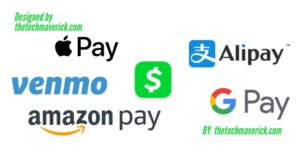The Pros and Cons of Using Mobile Payment Systems like Apple Pay and Google Pay in USA

Introduction
In recent years, mobile payment systems have revolutionized the way people conduct financial transactions. As a result, players like Apple Pay and Google Pay have become go-to platforms for millions of Americans. But are these systems truly beneficial or do they have some downsides? This article delves into the pros and cons of using mobile payment systems like Apple Pay and Google Pay in the United States.
Key Takeaways:
- Mobile payment systems like Apple Pay and Google Pay have become increasingly popular among Americans in recent years.
- Benefits of mobile payment systems include convenience, security, and functionality.
- Drawbacks of mobile payment systems include reliance on technology, limited merchant acceptance, potential security vulnerabilities, and user privacy concerns.
- The adoption of Apple Pay and Google Pay in the USA has been steadily increasing in recent years, but there are still many factors influencing market growth and penetration.
- When considering adoption of mobile payment systems, it’s important for individuals to evaluate their individual needs and preferences.
Advantages of Mobile Payments with Apple Pay and Google Pay
Mobile payment benefits are numerous, and Apple Pay and Google Pay are leading the way. In this section, we’ll explore the advantages that these two payment methods offer over traditional payment options.
Convenience
One of the most significant advantages of mobile payments is the convenience they offer. With Apple Pay and Google Pay, users can pay for goods and services with just a few taps on their phone. The need to carry cash or a credit card is eliminated, and payment can be completed from anywhere without the need for physical contact or a signature. Additionally, these payment methods provide a seamless checkout experience, reducing wait times and eliminating the need to enter billing information repeatedly.
Enhanced Security
Mobile payment security is a top priority for both Apple Pay and Google Pay. To keep user information safe, these payment methods use advanced encryption technology to protect transaction data. Additionally, both Apple Pay and Google Pay use biometric authentication (such as fingerprint scanning or facial recognition) to protect against fraudulent use. Finally, because mobile payments use tokenization to replace card details with a unique payment code, the user’s card information is not stored, lowering the risk of credit card fraud or data breaches.
Features
Apple Pay and Google Pay are not just convenient and secure, but they also offer features that go beyond traditional payment methods. Users can store multiple payment methods, including credit, debit, and loyalty cards, in one place. Furthermore, Siri or Google Assistant integration provides voice-powered access to these payment methods. Finally, peer-to-peer payment options (such as Apple Pay Cash or Google Pay Send) provide additional flexibility for transferring funds to friends and family.
| Advantages of Mobile Payments with Apple Pay and Google Pay |
| Convenience |
| Enhanced Security |
| Features |
Overall, the advantages of mobile payments with Apple Pay and Google Pay are clear. These payment methods provide ease of use, enhanced security, and additional features for users that traditional payment methods simply cannot match.
Convenience of Mobile Payments
Mobile payments have become increasingly prevalent due to their convenience and ease of use. Apple Pay and Google Pay are two of the most popular mobile payment systems, offering various features that make transactions quick and straightforward.
One of the main benefits of Apple Pay and Google Pay is contactless payment, allowing users to make payments without physically touching a terminal. This feature creates a more sanitary payment process and reduces the risk of spreading germs through cash or credit cards. Moreover, mobile payment systems have digital wallets that store users’ payment information and eliminate the need to carry physical wallets or purses.
Apple Pay and Google Pay also seamlessly integrate with other apps and services, making transactions even more convenient for users. For instance, users can make peer-to-peer payments through iMessage or Google Assistant, and payment details can automatically sync with expense tracking apps. This integration makes mobile payments more accessible and user-friendly than traditional payment methods.
Overall, mobile payment systems like Apple Pay and Google Pay offer a level of convenience that traditional payment methods cannot match. Their contactless payment features, digital wallets, and easy integration with other apps and services make them an excellent option for anyone looking for simple and straightforward transactions.
Enhanced Security Measures
When it comes to mobile payments, security is a top concern for users. Fortunately, both Apple Pay and Google Pay offer robust security features to protect user data.
One of the key security measures used by these payment systems is tokenization. This process involves replacing a user’s sensitive data, such as their credit card number, with a random string of characters, making it virtually impossible for hackers to access.
In addition, both Apple Pay and Google Pay use biometric authentication, such as fingerprint and facial recognition technology, to verify the user’s identity before completing a transaction. This ensures that only authorized users can access their accounts and make payments.
Transaction encryption is another security feature offered by these payment systems. This technology scrambles data during transmission, further protecting user information from potential breaches.
| Security Features | Apple Pay | Google Pay |
| Tokenization | ✔️ | ✔️ |
| Biometric Authentication | ✔️ | ✔️ |
| Transaction Encryption | ✔️ | ✔️ |
Overall, the enhanced security measures offered by Apple Pay and Google Pay have helped to make mobile payments a safe and secure option for users. As these technologies continue to evolve, it is likely that we will see even more advanced security features introduced to keep user data protected.
Features and Functionality of Apple Pay and Google Pay
Apple Pay and Google Pay offer various mobile payment features that make transactions seamless. Some of these features are:
| Features | Description |
| Loyalty program integration | Users can seamlessly store and redeem loyalty cards and rewards through the mobile payment systems. |
| Peer-to-peer payments | Users can easily send and receive money from friends and family within the mobile payment apps. |
| In-app purchases | Users can make in-app purchases securely and with ease. |
Moreover, both payment systems offer easy integration with other apps and services, making transactions faster and more convenient. Additionally, Apple Pay and Google Pay provide user-friendly interfaces and support multiple credit and debit cards.
Overall, the numerous features of mobile payment systems like Apple Pay and Google Pay make them user-friendly and versatile, ensuring a seamless and efficient transaction experience.
Drawbacks and challenges of mobile payments
While mobile payment systems like Apple Pay and Google Pay offer several benefits, there are also several concerns associated with their usage that users need to be aware of. Some of the significant drawbacks and challenges are as follows:
Reliance on technology
The successful use of mobile payment systems is heavily reliant on technology. If the technology fails, payments cannot be made. Additionally, users may not always have access to their smartphones, which can be a problem in situations where payments need to be made.
Limited merchant acceptance
Users may encounter challenges finding merchants that accept mobile payments, despite the growing popularity of these systems. Many small businesses and retailers are yet to adopt this payment method, making it challenging for users to utilize it.
Potential security vulnerabilities
While mobile payment providers have implemented various security features like biometric authentication, hackers can still find ways to exploit vulnerabilities.
User privacy concerns
The use of mobile payments could pose a risk to user privacy. User data, while encrypted, is still stored on devices and can be accessible to third-party apps.
Therefore, before using mobile payments, users need to weigh the risks and benefits and take precautions to safeguard their data and privacy.
Adoption of Mobile Payment Systems in the USA
Mobile payment adoption in the USA has seen a steady increase in recent years, thanks to the convenience and security offered by payment systems such as Apple Pay and Google Pay. In 2020, the mobile payment user base in the USA stood at approximately 100 million, with projections estimating it will reach over 150 million by 2025.
| Mobile Payment System | Market Penetration |
| Apple Pay | 47.3% |
| Google Pay | 39.1% |
| Other Mobile Payment Systems | 13.6% |
As the table above illustrates, Apple Pay currently holds the majority of the mobile payment market, with Google Pay following closely behind. Other mobile payment systems make up a smaller portion of the market but offer additional options for users.
The adoption of mobile payment systems is influenced by several factors, including consumer behavior, merchant acceptance, and technological advancements. While some consumers may prefer traditional payment methods, younger generations are more likely to embrace mobile payments. Additionally, merchants that accept mobile payments can provide a competitive advantage by offering a convenient and secure payment option.
As mobile payment systems continue to evolve and improve in functionality and security, it is expected that adoption rates will continue to rise in the USA.
Comparing Apple Pay and Google Pay
When it comes to mobile payment systems, Apple Pay and Google Pay are two of the most popular options available. While the basic concept of both payment platforms is the same, several key differences set them apart. For those undecided between the two, the following table offers a comprehensive comparison of the key features:
| Feature | Apple Pay | Google Pay |
| Compatibility | Works with iPhone, Apple Watch, and Mac | Works with Android devices |
| Merchant acceptance | Accepted at over 70% of merchants in the US | Accepted at over 3 million merchants in 70+ countries |
| Setup process | Straightforward setup process using existing Apple ID and payment card information | Requires manual entry of card information or scanning of physical card |
| Device integration | Seamlessly integrated with built-in iOS apps, enabling easy payments within apps and messages | Offers integration with Google services, such as Google Assistant and Google Maps, as well as app integration through Google Pay API |
| Security measures | Uses biometric authentication (Touch ID or Face ID), tokenization, and strong encryption to ensure secure transactions | Offers similar security measures to Apple Pay, including biometric authentication and tokenization |
While both Apple Pay and Google Pay offer ease of use and robust security features, the decision between the two ultimately depends on your device preferences and merchant availability. Apple Pay is widely accepted in the US but limited to Apple devices, while Google Pay can be used on a wider range of devices but has a lower merchant acceptance rate.
Conclusion
In conclusion, mobile payment systems like Apple Pay and Google Pay offer a range of benefits for users seeking convenience, security, and functionality. These payment methods are fast and easy to use, with features like contactless payments, digital wallets, and loyalty program integration making transactions seamless. Additionally, the security measures provided by Apple Pay and Google Pay, such as tokenization and biometric authentication, help protect user data and prevent fraud.
However, there are also challenges and risks associated with mobile payments, including potential security vulnerabilities, reliance on technology, and limited merchant acceptance. Therefore, it’s important for users to weigh the pros and cons of these payment systems and evaluate their individual needs and preferences before making a decision.
Overall, mobile payment adoption in the USA is growing, with more users turning to these payment methods for their transactions. Whether you choose to use Apple Pay or Google Pay ultimately depends on factors such as device compatibility, ease of use, and merchant acceptance. By considering these factors, users can choose the payment system that best fits their needs and preferences.
FAQ
What are the pros and cons of using mobile payment systems like Apple Pay and Google Pay in the USA?
Using mobile payment systems like Apple Pay and Google Pay in the USA comes with several advantages and challenges. On the positive side, mobile payments offer convenience, enhanced security measures, and a range of features. However, there can also be drawbacks such as reliance on technology, limited merchant acceptance, and potential security vulnerabilities.
What are the advantages of using Apple Pay and Google Pay?
Using Apple Pay and Google Pay offers several benefits. These mobile payment systems provide convenience by enabling quick and easy transactions. They also prioritize security with features like tokenization, biometric authentication, and transaction encryption. Additionally, Apple Pay and Google Pay offer a wide range of features and functionality, such as loyalty program integration, peer-to-peer payments, and in-app purchases.
How convenient are mobile payments with Apple Pay and Google Pay?
Mobile payments with Apple Pay and Google Pay are highly convenient. These systems allow contactless payments, digital wallets, and seamless integration with other apps and services. This makes transactions quick and easy, reducing the need for physical cards and cash.
What security measures do mobile payment systems like Apple Pay and Google Pay offer?
Mobile payment systems like Apple Pay and Google Pay prioritize security. They employ technologies such as tokenization, which replaces sensitive payment data with unique tokens, enhancing transaction security. Additionally, these systems utilize biometric authentication (such as fingerprint or face recognition) and transaction encryption to protect user data.
What features and functionality do Apple Pay and Google Pay offer?
Apple Pay and Google Pay offer a range of features and functionality. These include loyalty program integration, allowing users to earn rewards and access special offers. They also support peer-to-peer payments, enabling users to send and receive money easily. Furthermore, they facilitate in-app purchases, making it convenient for users to buy products and services within supported apps.
What are the drawbacks and challenges of mobile payment systems?
Mobile payment systems have some potential drawbacks and challenges. Users may face issues related to reliance on technology, as mobile payments require compatible devices and network access. Additionally, not all merchants accept mobile payments, limiting their usability. There are also concerns about potential security vulnerabilities and user privacy, although payment systems like Apple Pay and Google Pay employ measures to mitigate these risks.



Pingback: The future of mobile commerce and e-commerce platforms in USA